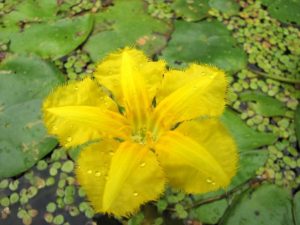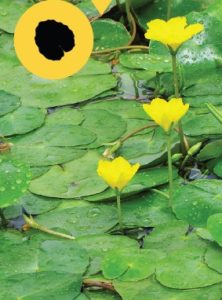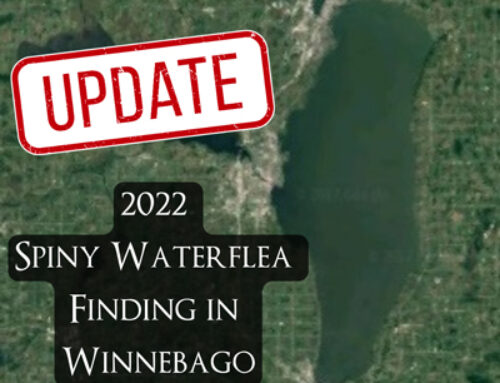Every month, we will put a spotlight on an aquatic invasive species (AIS) in a re-occurring monthly article. Check it out! This month, we highlight an emerging threat to Wisconsin lakes: Yellow Floating Heart!
Yellow Floating Heart
Yellow floating heart (Nymphoides peltata) is a perennial plant that is native to eastern Asia and the Mediterranean. As a popular ornamental plant in water gardens, yellow floating heart was introduced into waterways through intentional and accidental release. The plant can be transported by seed and plant fragments to new lakes on recreational gear. However, the most common method of spread is purchasing of the plant for water gardens across the country. Wisconsin has detected a few populations of yellow floating heart since it was first found in 2006 in a small pond in Dane County. It is illegal to possess or sell Yellow Floating Heart in Wisconsin.
Yellow floating heart grows in shallow water as a rooted plant. Heart-shaped leaves with wavy edges are one of the plants most recognizable features that help distinguish it from other native lily species. The undersides of the leaves are often purple. Flowers of the plant are yellow and grow above the water’s surface. Flowers have five petals that are fringed along the edges. The plant blooms between May and October.

The leaves of Yellow Floating Heart are very wavy! The silhouette of the leaf is in the upper left of the photo.
As it grows, yellow floating heart can slowly create dense patches and crowds out native plants. The floating leaves and flower structures often slow down water currents and can create stagnant areas of water with low oxygen, which can impact fish, ducks, and other wildlife. Dense mats of yellow floating heart can also impede recreational activities such as hunting, fishing, boating, and water skiing.
Yellow floating heart is classified as Prohibited across all counties in Wisconsin.
Want to help? HELP PREVENT THE SPREAD!
Every time you come off the water, make sure to follow these steps to stop the spread of faucet snails and other aquatic invasive species:
* Inspect boats, trailers, push poles, anchors, and other equipment for attached aquatic plants or animals.
* Remove all attached plants or animals
* Drain all water from boats, motors, livewells and other equipment
* Never move live fish away from a waterbody
* Never release aquarium plants or animals into your local waterways
Follow the Fox Wolf Watershed Alliance’s Winnebago Waterways Program on our Winnebago Waterways Facebook page or @WinnWaterways on Twitter! You can also sign-up for email updates at WinnebagoWaterways.org.
Questions? Comments? Contact Chris Acy, the AIS Coordinator for the Winnebago Waterways Program covering Fond du Lac, Calumet, and Winnebago Counties at (920) 460-3674 or chris@fwwa.org!
Winnebago Waterways is a Fox-Wolf Watershed Alliance program. The Fox-Wolf Watershed Alliance is an independent nonprofit organization that identifies and advocates effective policies and actions that protect, restore, and sustain water resources in the Fox-Wolf River Basin.
Photo Credit: Paul Skawinski, Chris Gladis
No changes were made to photos.





